
INTRODUCTION
In technology driven phase, Home Automation Technology (HAT) is existing in day to day activities from quite a while now. In many traditional cases, HAT proved to be algorithmic based executers or maybe, it has been a long drawn procedure. It is an orderly process which has been developing from numerous years. Every time a little change from the past form was noted. It was around 70 years back that “wired homes” appeared. Subsequently, home automation technology appeared in 1985. That improvement was path towards the current brilliant houses. A shrewd home is not which is pleasantly architecture or which has extravagant dividers or which is at a decent area or which has present day types of gear. It is one which has the most intelligent innovation in it. This makes the home savvy.
Prior, there were very few brilliant innovations. Individuals used to depend more on manual work than programmed work. Stanford University tried to think of some innovation in this field, however, they fizzled. They finished up some vital explanation behind not succeeding in exploratory examination .
- No inspiration to enhance residential work conditions.
- Limited association of clients in the innovation in the outline procedure.
- Perspective retained by item originators which was that household innovation was humdrum.
- Continuous spotlight on solitary apparatuses in configuration of contemporary innovation.
- For showcasing and specialized purposes, those four variables specified above have ended up becoming home industry’s chance and challenge these days.
Home automation is not another industry any longer, but rather it is a soaring industry in many of the developing nations [8]. Tremendous promise of business sector leads numerous hardware partnerships towards home automation. Apple and Sony organizations are attempting to claim a business sector based on home automation. Yet, the scale of home automation as an industry hasn’t shaped till now. There are additionally no common industry standards. The great and terrible combined items are in the business sector. When contrasted with mobile phone’s history, we can find that home automation has enormous potential later on. Indeed, a few years’ prior, not many individuals possessed an advanced cell phone or a Smartphone. Be that as it may, these days nearly everybody has a smart phone or has utilized an advanced mobile phone and IOS and Android framework is turning into the standard.
With the advent of new technology, people want more comfort in their lives. In this new era of automated things such as automatic cars, automatic dish washers, automatic bots and so on, comes the need of automated homes where people have the luxury of doing things with least amount of effort.
Also, this system is also built to help the disabled people with walking disabilities or old people who do not have energy to walk and switch off/on the home appliances. The basic motivation for building this product is to make the lives of people more comfortable and easy. It will give them a sense of security and also the comfort of stay at place and controlling systems through voice commands.
SYSTEM ARCHITECTURE
The proposed system offers voice controlled home automation using BitVoicer software that is compatible with Arduino, cheap and power effective. It allows controlling of devices using Voice based dynamic commands which reduce algorithmic user interaction with system directly. This framework contains of three principle segments:
- Intelligent environment disclosure sensor segment
- Intelligent Home Server (IHS) segment
- Voice based commands segment.
These different segments of the framework incorporate turning of any home apparatuses or gadgets such as tube lights, fans or air conditioners etc., as well as controlling the room brightness and the fan speed automatically. Let us see in detail about the components of these segments:
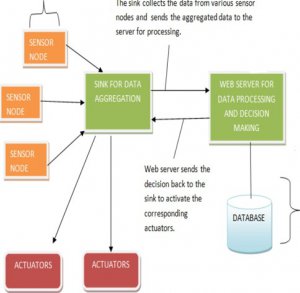
Figure 1. Home Automation Framework
Component I: Sensor Kit
This module consists of two sensors: Light Dependent Resistor (LDR) sensor and Digital Humidity and Temperature (DHT) sensor. LDR sensor checks the light intensity of the room. DHT sensor senses the environment and returns the value of current temperature and humidity.
Light Dependent Resistor sensor:
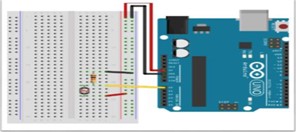
Figure. 2. LDR Sensor
LDR consists of a high resistance semiconductor which reacts to only light intensity. In the dark, a LDR will show a high resistance which can be up to several mega ohms (MO). In bright light, a LDR have very less resistance which can be equal be few hundred Ohms. If light incidence on a photo resistor exceeds a certain frequency, photons absorbed by the semiconductor give bound electrons enough energy to jump into the conduction band. The resulting free electrons conduct electricity, thereby lowering resistance. In this way, LDR sends less sensitive response to Arduino microcontroller.
Digital Humidity and Temperature Sensor:

Figure. 3. DHT Sensor
The DHTII is a basic, ultra low-cost digital temperature and humidity sensor. It uses a capacitive humidity sensor and a thermistor to measure the surrounding air, and spits out a digital signal on the data pin (no analog input pins needed). It’s fairly simple to use, but requires careful timing to grab data. The only real downside of this sensor is we can only get new data from it once every 2 seconds, so when using in library, sensor readings can be up to 2 seconds old.
Component II: Actuators, i.e., LEDs .
Actuators play an important role in this system as they are the output formats which are activated whenever a user gives any command. We have used different LEDs for various devices such as fan, tube lights and air conditioners. LEDs have been used because they consume less power and Arduino being a low powered device, can withstand only minimal power for every component.
Component III: Server & Ethernet shield
The Arduino ethernet shield allows an Arduino board to connect to the internet. It is based on the Wiznet W5100 ethernet chip. The Wiznet W5100 provides a network (IP) stack capable of both TCP and UDP. It supports up to four simultaneous socket connections. Arduino sends data to ethernet shield where it connects to server. The server (coded in PHP) then processes the data and sends command to Arduino via Ethernet shield.
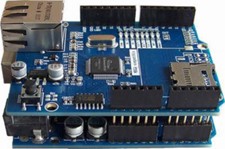
Fig. 4. Ethernet Shield
The Arduino Ethernet shield allows an arduino board to connect to the internet. It is based on the Wiznet W5100ethernet chip (datasheet). The Wiznet W5100 provides a network (IP) stack capable of both TCP and UDP. It supports up to four simultaneous socket connections. The Ethernet shield connects to an Arduino board using long wire-wrap headers which extend through the shield.
Component IV: RF transmitter and Receiver
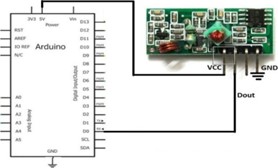
Figure. 5.1 RF Receiver Module
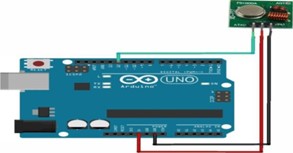
Figure. 5.2 RF Transmitter Module
An RF module (radio frequency module) is a small electronic device that is used in transmitting and receiving data wirelessly. In embedded systems, it is often used to transmit and receive data wirelessly. This wireless communication may be accomplished through radio frequency (RF) communication. In proposed work the RF module is used to carry the unique id of the particular lamp post, it also carries the flag which gets high if the object stays in the particular range for more than the given time.
Component V: BitVoicer
BitVoicer is a software by BitSophia Inc. It is a voice controlling software which is compatible with Arduino. Through BitVoicer, we can give commands to the Arduino board and by interfacing Arduino with BitVoicer, the functionality can be controlled.
Component VI: Arduino
The Uno is a microcontroller board in light of the ATmega328P. It has the following component types:
- MCU- Atmega 328
- Input Voltage- 7v-12V
- Operating Voltage- 5 V
- CPU Speed-16MHz
- Analog in/out- 6/0
- Digital I/O/PWM- 14/6
- EEPROM- IKB
- SRAM- 2KB
- Flash- 32KB
- UART-I
- USB-Regular
- Digital
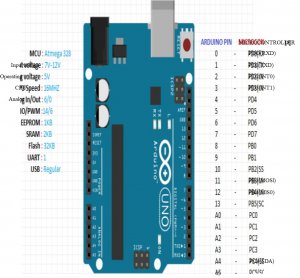
Figure. 6. Arduino Board
WORKING OF THE SYSTEM
The proposed home automation system is an integrated system to facilitate elderly and disabled people with an easy to use that can be fully operated on voice commands. It is portable and constructed in a way that it is easy to install, configure, run and maintain. It works in two following modes:
- Automatic Mode
In the installed system when the user wants to function automatically, first the voice command saying “keyboard on” to be issued. Second, verification of components such as temperature and dampness (humidity) alongside different elements performed for a remote observing framework using Wi-Fi (Fig. 7). These hubs send information remotely to a central server, which gathers the information, caches it and permits it to be examined and showed as required.
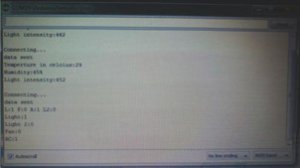
Figure. 7.1 keyword “on”-Automatic control of electrical appliances.
The knowledge base here is an IOT (Internet of Things) platform that tracks all the voice commands provided, also it can be used online base to receive remote sensor readings to store temperature and environment information. Based on these values, the system triggers the necessary actuators such as AC, Fan or tube light.
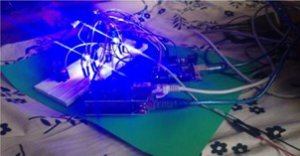
Figure. 7.2 LEDs have been switched on as shown. They are LEDs of AC and light.
Once the room conditions are favorable, the devices which are not required are switched off. This way energy is conserved. The cycle will repeat itself after a few minutes so that the user can get optimum comfort.
- Manual Mode
If the user is not in need of automatic mode, he can switch to manual mode by issuing the voice command “Autohome”. This command will stop the sensors and now the control of the system lies in the hands of the user. A user has 4 options now. He can give the following commands to the system within 3 seconds of uttering the term “Autohome”.
- “Fan”- This command will switch the current fan state(Figure 8).
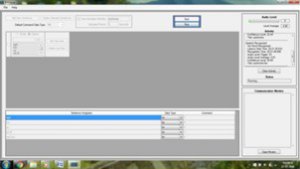
Figure. 8 1. “Autohome Fan” Command
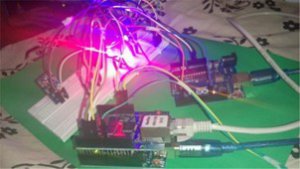
Figure. 8 2. Fan’s LED (Red LED) on.
- “Light”- This command will switch the current light state.
- “AC”- This command will switch the current air conditioner state.
- “All off’- This command will switch off all electrical devices (Figure 9).
If the user wants to again switch to automatic mode, he can again say the keyword “on” and the system will switch to automatic mode.
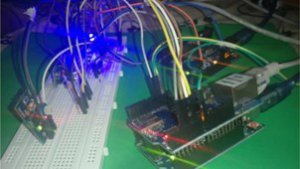
Figure. 9. All off Command
With the above results, we can say that the system is working properly and there is hardly any chance of any error unless a system breakdown occurs. The system might be a tad slow because of so many devices connected to it but this problem can be solved by using a high powered Arduino instead of the low powered one.
CONCLUSION
The proposed system is very useful for elderly and physically disabled persons who are in need of a physical assistance for daily needs. It eliminates the limitation of wiring complications also the range of voice commands can be extended by using wireless routers and IOT. On the off chance the viable usefulness and the cost of home automation decrease will enable compatibility with future technologies for customized user support. It implies that creation capacity as well as innovation level ought to enhance increasingly. In Future, the use of Arduino can enable the control via. , centralized server through smart mobile phones.


COMMENTS